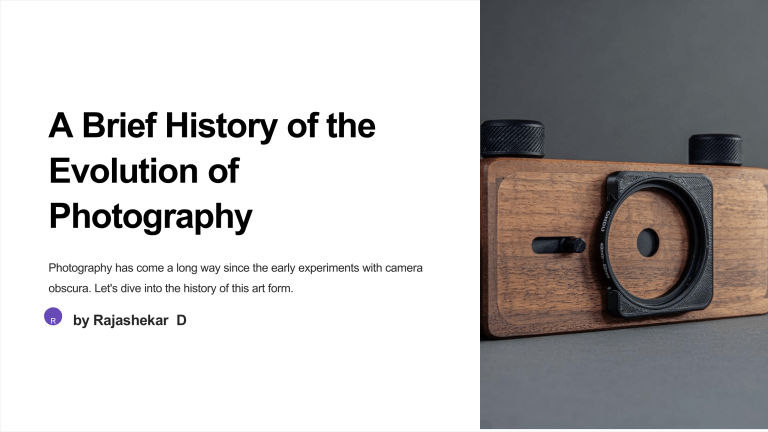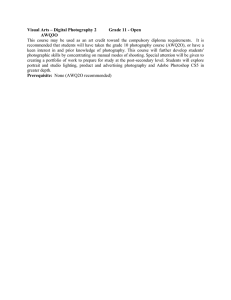
A Brief History of the Evolution of Photography Photography has come a long way since the early experiments with camera obscura. Let's dive into the history of this art form. R by Rajashekar D Photography What it is, How it works and How it was invented. What is Photography? • The word photography comes from two ancient Greek words: photo, for "light," and graph, for "drawing." Therefore, a literal translation of Photography is Drawing with light. • When a photograph is made, light or some other form of radiant energy, such as an X- ray, is used to record a picture of an object or scene on a light-sensitive surface. • Today, photography has become a powerful means of communication and a mode of visual expression that touches human life in many ways. For example, photography has become popular as a means of recording memories. • Most of the billions of photographs taken today are snapshots--casual records to document personal events such as vacations, birthdays, and weddings. Purposes of Photography • Photography is used in nearly every human endeavor from astronomy to medical diagnosis to industrial quality control. • Photographs can also be objects of art that explore the human condition and provide aesthetic pleasure (for people to enjoy looking at). For millions of people, photography is a satisfying hobby or a rewarding career. Photography as Art: • When photography was first invented, some people believed that it was not an art-form because photographs were created by a machine. • Artists argued that the camera is simply the tool used to create. The art is in the photographer’s selection of what to include in their photos. Photography As Art: • Today photography is widely recognized as a fine art. Photographs are displayed in art museums, prized by collectors, discussed by critics, and studied in art history courses. How Photography Began: • Leonardo DaVinci, a very famous Rennaissance artist and inventor, is credited with creating the first camera. • DaVinci’s “Camera Obscura” was a large room completely sealed from light except for a very small hole in one wall. An image of the outside world--houses, trees, and even people--could be projected, upside down and reversed right-to-left, onto a wall or white screen placed opposite the opening. Drawing of a Camera Obscura Right- A Modern day camera obscura Making the Image Permanent • In the early 19th century Joseph-Nicephore Niepce of France developed a process whereby he could permanently capture the image of a camera obscura. In 1827 he made the world's first surviving photograph from the window of a country home in France. It required an exposure, in bright sunlight, of eight hours. Daguerre • Louis Daguerre worked with Niepce on a different approach. In Daguerre’s process, a silver-coated sheet of copper was sensitized by treatment with iodine vapor, forming a coating of light-sensitive silver iodide. • Daguerreotype-This method made photos that lasted longer and where much clearer. Daguerreotype • This type of Photo, called a daguerreotype, recorded only one image which could not be re-printed. Talbot • In England William Henry Fox Talbot had developed his own method of photography at about the same time that Daguerre was inventing the daguerreotype. Talbot coated paper with silver nitrate or silver chloride. • Talbot’s method for recording photographs on paper was modified many times to arrive at the high quality photo paper we use today, but the idea is still the same. William Henry Talbot- 1884 Archer • In 1851 F. Scott Archer of England came up with the first portable photography process. • Archer used a wagon to transport his photography materials, and recorded photographic images on plates, much like the negatives your images will be recorded on. • Archer’s technique was also less expensive than previous photographic techniques. Left- Photograph and Drawing of the type of Camera that Archer used. The cloth over the photographer’s head keeps light away from the light-sensitive plate. Photography by F. Scott Archer Photography Goes Public • In the 1880s the American George Eastman put flexible roll film on the market, and in 1889 he introduced the first Kodak camera with the slogan, "You push the button and we do the rest. • In the next century, the camera would undergo many changes, giving a much greater audience access to photography. The Camera Obscura Invention Development Influence Camera obscura was invented The camera obscura was further The camera obscura was used as a around 500 BCE in China. It was a improved by Arab scholars and tool for drawing, painting, and as a device that used a small hole to European artists in the 9th and 16th precursor to modern photography. project an image onto a surface centuries. inside a darkened room. Camera Obscura: The concept of capturing images through a pinhole or small opening dates back to ancient times. The camera obscura, a darkened room or box with a small hole in one side, projected an inverted image onto the opposite wall or surface. Daguerreotype: In 1839, Louis-JacquesMandé Daguerre introduced the daguerreotype process, which was the first commercially successful photographic technique. It involved exposing a silver-coated copper plate to light, creating a unique positive image. Calotype and Paper Negatives: Around the same time, William Henry Fox Talbot developed the calotype process. It used paper negatives to create multiple prints from a single exposure, making it a more practical technique. The Camera History Collodion Process and Wet Plate Dry Plate Photography: In the 1870s, Roll Film and Kodak: In 1888, George Photography: In the 1850s, Frederick Richard Leach Maddox introduced dry Eastman introduced the Kodak Scott Archer introduced the collodion plate photography, which eliminated camera, which used roll film instead process, which involved coating a the need to develop plates while wet. of glass plates. The camera was pre- glass plate with a light-sensitive Dry plates were more convenient and loaded with film, and after capturing collodion solution. The plate had to could be prepared in advance, images, the entire camera was sent be prepared and developed while still making photography more accessible. back to Kodak for film processing and wet, leading to the term "wet plate reloading. This made photography photography." This technique allowed more user-friendly and popularized for more detailed and sharper the medium. images. The Camera History Flexible Film and 35mm: In the early Color Photography: The first color Digital Photography: The advent of 20th century, flexible film was photograph was taken in 1861 by digital technology revolutionized introduced, allowing for smaller, James Clerk Maxwell, but practical photography in the late 20th century. more portable cameras. In 1934, color photography required further The first digital camera was Kodak released the Kodak 35 camera, advancements. In the early 20th developed in 1975 by Steven Sasson which utilized 35mm film. The 35mm century, processes such as at Kodak. Digital photography format became widely adopted and is Autochrome, Dye-Transfer, and eliminated the need for film and still used today. Kodachrome were developed, introduced various benefits such as enabling the capture of color images. instant image preview, storage on memory cards, and easy image manipulation. Modern Advances: With the rapid advancement of digital technology, photography has become more accessible and versatile than ever. High-resolution digital cameras, smartphones with powerful built-in cameras, and various software applications have transformed the way we capture, edit, and share photographs. Invention of the First Camera Nicéphore Niépce Louis Daguerre George Eastman The first true camera was invented by Louis Daguerre invented the In 1900, George Eastman introduced the Frenchman Nicéphore Niépce in the early daguerreotype in 1839. It was the first Kodak Brownie camera, which made 1820s. He used a camera obscura to commercially successful photographic photography accessible to the masses. create the first permanent photographic process. image. Evolution of Cameras and Technology 1 2 3 Film cameras Digital Cameras Smartphone Cameras Film cameras remain popular until Digital cameras replace film cameras Smartphones revolutionize the 2000s. in the 21st century. photography with high-quality built-in cameras and app features. The First Permanent Photograph Nicéphore Niépce Annie Leibovitz National Geographic The first permanent photograph was Annie Leibovitz is considered one of the National Geographic is famous for its taken by Niépce in 1826. The image, best portrait photographers of all time, world-class photography, capturing known as "View from the Window at Le known for her celebrity portraits for Rolling stunning images of wildlife, landscapes, Gras" shows a view from his window in Stone and Vanity Fair. and cultures around the world. France. Spread of Photography 1 Photojournalism 2 Family Photography Photography revolutionized Photography has become journalism, changing the an integral part of way we experience news documenting family and events around the memories and milestones, world. with the popularity of family portraits, selfies, and social media sharing. 3 Fine Art Photography Photography has become an important art form, with artists such as Ansel Adams, Edward Weston, and Cindy Sherman making significant contributions to the world of fine art photography. Photography in the Digital Age Pros Cons • Instant results • Digital noise • Endless storage • Lesser dynamic range • Easy sharing options • Photographers becoming less skilled Future of Photography 1 AI and Machine Learning Artificial intelligence and machine learning are playing Virtual Reality 2 an increasingly big role in photography. 3 3D Printing Virtual Reality will transform photography by creating new ways to experience and interact with images. 3D printing will enable photographers to create new forms of art by transforming images into physical objects.



